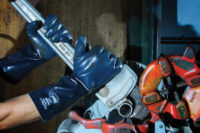 At one time or another, everyone has had a minor injury to a finger, hand, or wrist that caused pain or swelling. Most of the time our body movements do not cause problems, but it's not surprising that symptoms develop from every day wear and tear, overuse, or an injury.
At one time or another, everyone has had a minor injury to a finger, hand, or wrist that caused pain or swelling. Most of the time our body movements do not cause problems, but it's not surprising that symptoms develop from every day wear and tear, overuse, or an injury.
Finger, hand, or wrist injuries most commonly occur during:
- Sports or recreational activities.
- Work-related tasks.
- Work or projects around the home, especially if using machinery such as lawn mowers, snow blowers, or hand tools.
- Accidental falls.
- Fistfights.
The risk of finger, hand, or wrist injury is higher in contact sports, such as wrestling, football, or soccer, and in high-speed sports, such as biking, in-line skating, skiing, snowboarding, and skateboarding. Sports that require weight-bearing on the hands and arms, such as gymnastics, can increase the risk for injury. Sports that use hand equipment such as ski poles, hockey or lacrosse sticks, or racquets also increase the risk of injury.
In children, most finger, hand, or wrist injuries occur during sports or play or from accidental falls. Any injury occurring at the end of a long bone near a joint may injure the growth plate (physis) and needs to be evaluated.
Older adults are at higher risk for injuries and fractures because they lose muscle mass and bone strength (osteopenia) as they age. They also have more problems with vision and balance, which increases their risk of accidental injury.
Most minor injuries will heal on their own, and home treatment is usually all that is needed to relieve symptoms and promote healing.
An acute injury may occur from a direct blow, a penetrating injury, or a fall, or from twisting, jerking, jamming, or bending a limb abnormally. Pain may be sudden and severe. Bruising and swelling may develop soon after the injury. Acute injuries include:
- Bruises. After a wrist or hand injury, bruising may extend to the fingers from the effects of gravity.
- Injuries to ligaments, such as a skier's thumb injury.
- Injuries to tendons, such as mallet finger.
- Injuries to joints (sprains).
Overuse injuries occur when too much stress is placed on a joint or other tissue, often by "overdoing" an activity or repeating the same activity. Overuse injuries include the following:
Carpal tunnel syndrome is caused by pressure on a nerve (median nerve ) in the wrist. The symptoms include tingling, numbness, weakness, or pain of the fingers and hand.
Tendon pain is actually a symptom of tendinosis, a series of very small tears (microtears) in the tissue in or around the tendon. In addition to pain and tenderness, common symptoms of tendon injury include decreased strength and movement in the affected area.
De Quervain's disease can occur in the hand and wrist when tendons and the tendon covering (sheath) on the thumb side of the wrist swell and become inflamed.
Treatment for a finger, hand, or wrist injury may include first aid measures; medicine; "buddy-taping" for support; application of a brace, splint, or cast; physical therapy; and in some cases, surgery.
Treatment depends on:
- The location, type, and severity of the injury.
- How long ago the injury occurred.
- Your age, health condition, and activities (such as work, sports, or hobbies).
Check your symptoms to decide if and when you should see a doctor.
- Pulled muscles (strains).
- Broken bones (fractures), such as a wrist fracture .
- Dislocations.
- Review health risks that may increase the seriousness of your symptoms.
- See significance of a finger, hand, or wrist that looks twisted, bent, or out of its normal position.
- See significance of pain or tenderness.
- See significance of pale, white, blue, or cold fingers or hands.
- See significance of numbness or tingling.
- See significance of inability to move normally.
- See significance of swelling.
- See significance of a snap, pop or grating.
- See significance of inability to free a trapped finger or hand.
- See significance of signs of infection.
- See significance of an object in your finger or hand.
If you have any of the following symptoms, evaluate those symptoms first.
- Bleeding.
- Puncture wound or injection of a foreign body under high pressure.
- A finger, hand, or wrist problem not related to an injury.
- Injury from cold exposure.
- A burn to a finger, hand, or wrist.
- A bite to a finger, hand, or wrist.
- A fingernail problem or blood under a nail.
Source: WebMD www.webmd.com








